-
Posts
1,025 -
Joined
-
Last visited
Content Type
Profiles
Forums
Store
Help Articles
Posts posted by albiston
-
-
Andrew, thanks for the gourd/cucumber pic. It certainly looks a lot like the one in my shot. I made the assumption it was something sweet because of the other objects on the plate, which look like fruit and pastry items to me.
Hathor, as far as I could undertsand the idea behind the ice was that during the period in which the ice melts and starts simmering you will be extracting flavor from your main ingredient in a slow and delicate way. That should give you a smoother taste. Does it really makes sense? I don't know, and I'm not even sure I perfectly understood chef Guarino's explanation.
-
Schmalz is rendered chicken fat. Easy to make on your own. You could probably sub duck fat or shortening, but the flavor and mouthfeel of the end product would be different.
Not sure this is necessairly the case. What I find under the name "Schmalz", when I visit my local supermarket here in Germany, is usually rendered pig fat and not chicken. Never seen chicken around here, while goose fat (Gänseschmalz) is quite common.
-
Gambero Rosso's "Tre Forchette" are out too. 22 restaurnats win the prize this year, two more than last year. Compared to the 2005 list there are two names missing, Teverini and La Siriola, a return, Da Caino, and three new entries -Cracco Peck, Combal.zero and Uliassi- none of which particularly surprising.
I'll add the ranking for the cooking (GR has a separate note for that) and the special prizes like the tre Gamberi osterie later, once they're made public. For the moment here's the 22 winners (and where they are):
Pierangelini, San Vincenzo; Vissani, Baschi - 96
Don Alfonso, Sant'Agata sui due Golfi; La Pergola, Rome; Dal Pescatore, Canneto sull'Oglio - 93
Ambasciata, Quistello; Le Calandre, Rubano; Enoteca Pinchiorri, Florence; La Torre del Saracino, Vico Equense - 92
Laite, Sappada; Villa Crespi, Orta San Giulio - 91
Villa del Quar, Pedemonte; Da Caino, Montemarano; Colonna, Labico; Combal.zero, Rivoli; Cracco Peck, Milan; Desco, Verona; Lorenzo, Forte dei Marmi; Madonnina del Pescatore, Senigallia; Perbellini, Isola Rizza; St.Hubertus, San Cassiano; Uliassi, Senigallia - 90
-
Alberto, I don't think you peer into the soul of Italian restaurants until you get to Antica Corona da Renzo in Piemonte. What do you think? Regardless, thank you for giving us a preview.
Robert, unfortunately my knowledge of Piemonte is poor and mostly concentrates on Torino. Your co-host is a damn Southerner
 .
. -
That looked like a fabulous fish class! I'm jealous! Just having access to those fish is incredible. I'm having culture shock being back in NY, all the fish here is so 'processed', no heads, no bones, just fish flesh so clean you have no real idea what fish its from.
Don't get me started: at least you can get great fish in NYC. Here....
 .Would you mind describing how the two stocks were made? Also a little more description on the tomato-EVOO emulsion.
.Would you mind describing how the two stocks were made? Also a little more description on the tomato-EVOO emulsion.Grazie!
Sure. The tomato-EVOO emulsion is extremely simple. Just take some nice ripe tomatoes, peel them and seed them, then chop them fine. Puree them with an immersion blender, add a little salt (which you'll correct to taste at the end), and start pouring a thin but continuous stream of EVOO in the tomato puree while blending all the time. When it starts thickening up and turns from red to a more orange tint it's done. You'll need quite a bit of EVOO.
The stock were made using a method I had never seen before, using ice. Essentially the base ingredient, be it the scorpion fish or the shrimp shells, were "browned" in EVOO in a pot big enough to hold the fishes in a single layer, together with some aromatics (I think we used only onion, tomato and just a touch of garlic). When the fish were done, i.e. when the first signs of caramelization appeared, chef Guarino covered the contents of the pot with crushed ice (just enough to cover the fish completely) and reduced the flame. We waited till the ice melted and the stock started to simmer at a slow boil. After 1-1.5 hours, the stock was sieved and reduced a little.
The result was an incredibly tasty stock, but a cloudy one.
On that issue I would be curious to know what experiences you have had with stock during your Slow Food classes.
-
As usual the season of Italian Restaurant guides has been opened by L'Espresso (Italy's leading weekly). L'espresso uses the 20 points score scale made popular by Gault and Millau, with 20 being the maximum. Here are the top restaurants according to the guide:
- 19.5/20: 'Gambero Rosso', San Vincenzo (Li); 'Vissani', Baschi (Tr).
- 19/20 : 'Hotel Cavalieri Hilton la Pergola', Roma; 'Le Calandre', Rubano (Pd).
- 18.5/20: 'Dal Pescatore', Canneto sull'Oglio (Mn); 'Enoteca Pinchiorri', Firenze.
- 18/20 : 'Gualtiero Marchesi', Erbusco (Bs); 'Miramonti l'Altrò, Concesio (Bs), 'Perbellini', Isola Rizza (Vr).
- 17.5/20: 'Combal Punto Zero', Rivoli (TO); 'Cracco-Peck', Milano; 'Osteria la Francescana', Modena.
- 17/20: 'Aimo e Nadia', Milano; 'Antica Corona reale-da Renzo', Cervere (CN); 'Antonello Colonna', Labico (RM); 'Colline Ciociare', Acuto (FR); 'Da Vittorio', Brusaporto (BG); 'Don Alfonso 1890', Sant'Agata sui Due Golfi (NA); 'Duomo', Ragusa (RG); 'Hotel Rosa Alpina St.Hubertus', Badia-Abtei (BZ); 'Paolo e Barbara', San Remo (IM); 'Sadler', Milano; 'San Domenico', Imola (BO); 'Taverna del Capitano', Massa Lubrense (NA); 'Uliassi', Senigallia (AN).
- 16,5: 'Agata e Romeo', Roma; 'Al Sorriso', Soriso (NO); 'Antica osteria del Ponte', Cassinetta di Lugagnano (MI); 'Antica osteria del teatro', Piacenza; 'Caino', Montemerano (GR); 'Capriccio', Manerba del Garda (BS); 'Desco', Verona (VR); 'Dolada', Pieve d'Alpago (BL); 'Dolce stil novo', Ciriè (TO); 'Flipot', Torre Pellice (TO); 'Gambero', Calvisano (BS); 'Hotel Certosa di maggiano il canto', Siena; 'Il Convivio Troiani', Roma; 'La Caravella', Amalfi (SA); 'Locanda Arnolfo', Colle di Val d'Elsa (SI); 'Lorenzo', Forte dei Marmi (LU); 'Madonnina del pescatore', Senigallia (AN); 'Peca', Lonigo (VI); 'Pierino Penati', Viganò (LC); 'Rigoletto', Reggiolo (RE); 'Romano', Viareggio (LU); 'Symposium', Serrungarina (PS); 'Torre del saracino', Vico Equense (NA); 'Zur Rose', Appiano sulla Strada del vino (BZ).
-
Wow, wow, wow.
And that was just the morning?
Indeed, though we only had a little bite from each of the dihses... well mostly. I couldn't resist the grilled tuna dish. It was just sooo nic e that I had to have one taste, then another and then just a few more bites.
What's ragusano cheese like?Ragusano is a sort of caciocavallo, which is peculiar because it is shaped into a bis "brick" before it is tied up and left hanging for the seasoning stage. The taste and use varies with age. It can be cooked (fried for example) when young and unsalted. The one with middle aging is used as table cheese and the forms that are aged 12 months or more are usually employed grated. The older the cheese gets the more it loses the characteristics of cheeses made with the pasta filata method (like mozzarella, scamorza, etc.). The best Ragusano cheeses are made from the milk of cows of the Modicana race which are free to eat the wild grasses and herbs growing in the area. More (and a couple of pics) in the next post, as soon as I finish touching up the pic files.
It looks like the tuna wasn't cooked all the way through, the way you've noted is traditional. Do you think tuna cooked more rare is coming into vogue now?You get both now, though probably medium or rare tuna is easier to find in "creative" places.
What was the weather like? Did you have a lot of problems with the seasonal closings?We were quite lucky with the weather, temperatures in the upper 20C- lower 30C range and only a little rain on our last day. Compared to Puglia last year we had very few problems with seasonal closing, but I guess that has to do with Southern Sicily having a longer tourist season, though we met no masses of tourists during our stay.
-
Sicily, at last. During our stay we chose to set our home base in the charming Hotel relais in Modica. The city itself, or better the old parts of Modica Alta and Bassa are a gem of Sicilian Baroque architecture, the people are friendly and happy to help... but you better be fit: half of the streets you see on a Modica map are actually stairs
 .
. 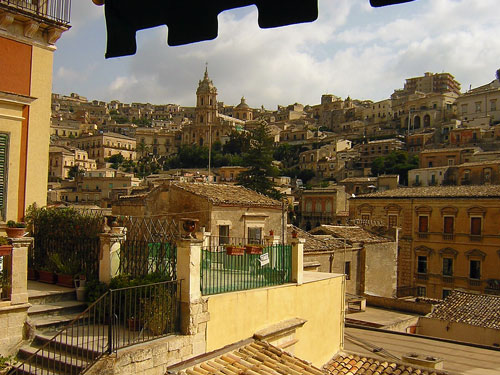
We spent our first day doing the tourist thing, though every time we stopped someone to ask for directions we also got dining tips without asking. It just gives you the idea of what place food has in people's minds around here. Unfortunately all the places that were suggested were closed on that day, so we more or less followed our nose and landed in a very simple rosticceria, making some fantastic scacci, a savory bread/focaccia rolled up like a strudel. The one with ricotta and sausage was simply fantastic, and at one euro apiece I don't think one could find a better price quality ratio anywhere. The place is in Modica Bassa, in the small via Pozzo Barone, just at the end of the Corso Umberto. I've always wondered where the Stomboli bread that's popular in the US and UK comes from: after seeing scacci I suppose it is an evolution of this Modican dish.
The following day we had an early start, looking forward to a morning of fish dishes demos and tasting. My wife and me had been kindly invited by Ronald Ashri and Katia Amore, who run the loveSicily holiday service, to join one of the classes of their Autumn cookery course. 9 AM is probably not the time most people would choose to power taste fish dishes, but it was great fun, especially after a few glasses of the different Sicilian whites that were served along with the fish. I'll only give a brief description of the dishes demoed by chef Savatore Guarino of Masseria degli Ulivi in Noto, but if you have any questions just fire away, I took quite a few notes.
After a little gutting and cleaning to get our hands dirty straightaway, we kicked of cooking preparing the two fish stocks we would be using during the class: a prawn shell stock and one made with the rock fish below.
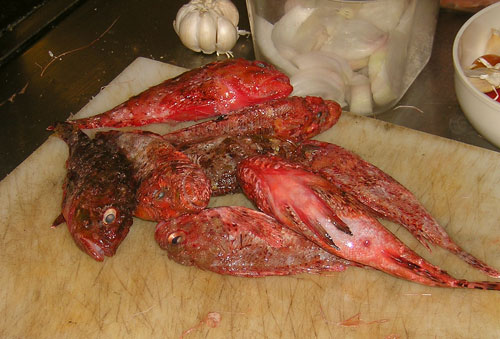
Anchovy tortino, filled with tomatoes, bread crumbs, herbs and Ragusano cheese, with tomato EVOO emulsion (made saying "we add just a dash of EVOO" and then pouring half a bottle of the stuff in with the tomatoes
 ):
):
Fried sardines stuffed with a tuna tomato sauce, served on a violet cauliflower puree and fish stock "soup". Looks a bit unusual but tasted great.
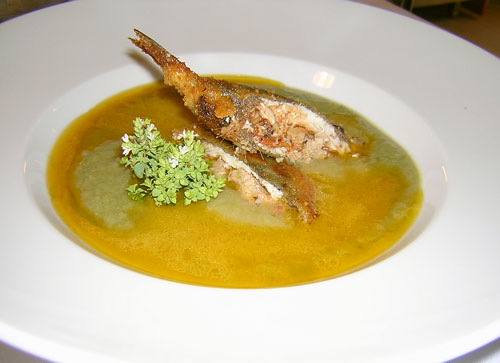
One of the main focuses of the class was clearly tuna, which simply pervades Sicilian costal cooking. Chef Salvatore had bough a nice piece of tail filet from a 200kg (or was it 300?) tuna at the market that very morning, and he demonstrated two dishes with it, a classic one and a slightly more modern/creative one.
While the more traditional cipollata di tonno was simmering, we turned to the "modern" dish.
The tuna, cut into steaks, was first grilled on a fire made with citrus, olive and carob wood which smelled simply divine.
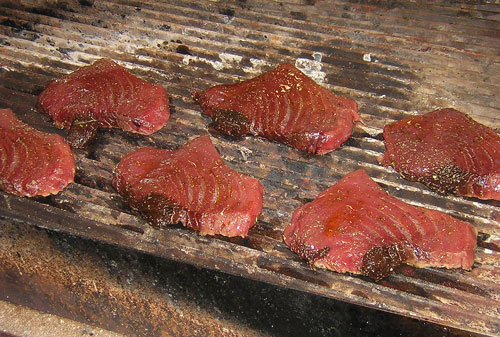
The steaks were served with melted ricotta-filled mozzarella on top of the tomato-EVOO emulsion (used for the anchovy tortino) enriched with fish stock. So simple, yet one of the best dishes we tasted during our vacation.

The tuna cipollata. the sauce is, as far as I can remember: loads of onions, tomato, EVOO (clearly), oregano and some Ragusano cheese. Cheese with fish is a blasphemy for a nEapolitan like me, but it works great here.
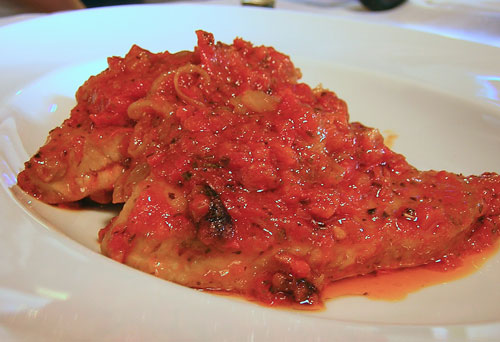
The other attraction of the day was this big dentex
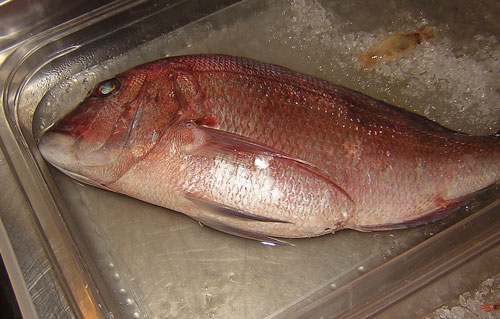
It was cooked in a sea salt crust after being stuffed with pomegranate slices and served with a fig-pomegranate sauce and some red pepper marmalade.
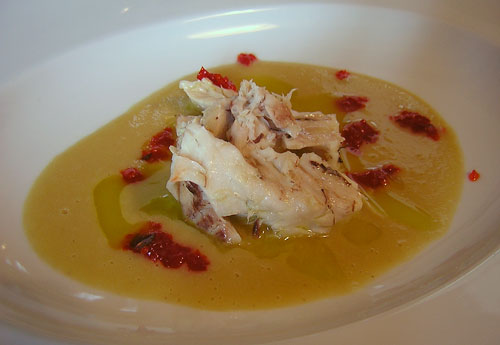
If that wasn't enough (boy were we stuffed by then) we finished the morning off with dolphinfish served in stimpirata, a sweet-sour preparation usually reserved for rabbit, which I forgot to take a picture of.
The rest of the day was spent visiting the estate of Felice Modica tasting some of the wines and olive oils produced here. The wines are nice, but the real star is olive oil. The two EV oils produced here have been awarded quite a few prizes and earned many positive reviews, like this one from the Lo mejor de la gastronomia's initiator and editor Rafael Garcia Santos.
No big dinner after all the stuff we had during the day and since we were going to have lunch at Il Duomo the next day (I wrote about that here).
-
Is it traditional in Neapolitan doughs to let them ripen or age for so long, or do they pretty much make and bake the same day? Is there any part of Italy where such a long ripening is traditional, if not in Naples?
There are others here who can reply with more knowledge, in particular our member Pizza Napoletana who is writing a book on the topic. Since he drops by only occasionaly I'll try to reply leaving room for his corrections.
For what I know longer times are quite traditional in Naples, though one should be thinking 12-16 hours and not 24 or 48. I would imagine that pizzerie that still use sourdough (very few) might ripen their dough even longer. I think long times were usual in the past. Then, once the stronger Canadian and US flour sorts became more widely available, many pizzerie developed methods, wich allowed for quicker rises (and less work, less risk, etc) but compromised dough flavor, while others stuck to the old recipes. I have the feeling that today there is a new generation of pizzaioli (pizza chefs?), not necessairly tied to the Neapolitan tradition, that are rediscovering tradition and going beyond that.
-
Before I jump to the Sicilian part of our vacation, I wanted to post a couple of pizza pics from Naples. I was actually looking forward to trying out a couple of new pizzerie that I had heard a lot about in the last couple of years, particularly "Il Pizzaiolo del presidente", or at least visiting a favourite of mine, Starita on Via Materdei. Unfortunately all of them were booked full and so the simple solution was to buy a pizza to go with all the trimmings from a decent pizzeria near my parent's place, Vittoria on Via Pisciscelli.
The "trimmings", a plate of Neapolitan fritto misto:
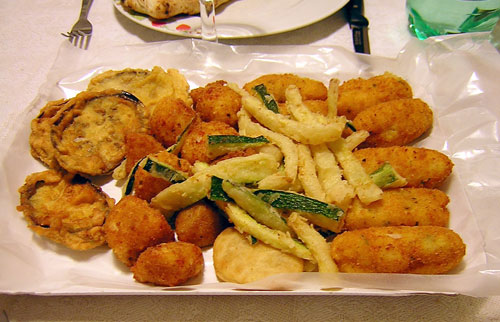
and pizza, a simple margherita made with provola, i.e. smoked mozzarella:
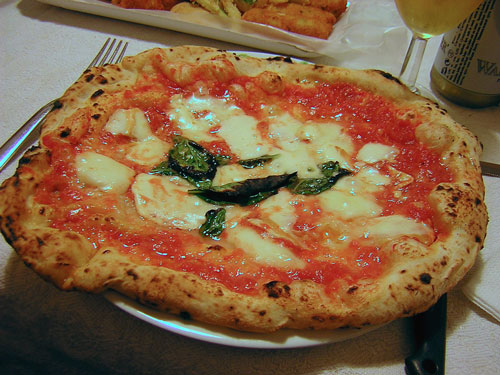
Since one pizza was not enough
 my little brother -little as in younger, he's 10 cm taller than me and a few kilos heavier- brought a few samples from a joint specializing in pizza al taglio, called Happy Hour (terrible name, I know), where he helps out from time to time. Pizza al taglio is not so popular in Naples, and no wonder with all the great pizza out there, and more commonly associated with Rome. The guy running this place is trying to bring great pizza al taglio to Naples. He certainly puts a lot of effort in using great ingredients and makes an impressive dough, ripened for 48 hours.
my little brother -little as in younger, he's 10 cm taller than me and a few kilos heavier- brought a few samples from a joint specializing in pizza al taglio, called Happy Hour (terrible name, I know), where he helps out from time to time. Pizza al taglio is not so popular in Naples, and no wonder with all the great pizza out there, and more commonly associated with Rome. The guy running this place is trying to bring great pizza al taglio to Naples. He certainly puts a lot of effort in using great ingredients and makes an impressive dough, ripened for 48 hours.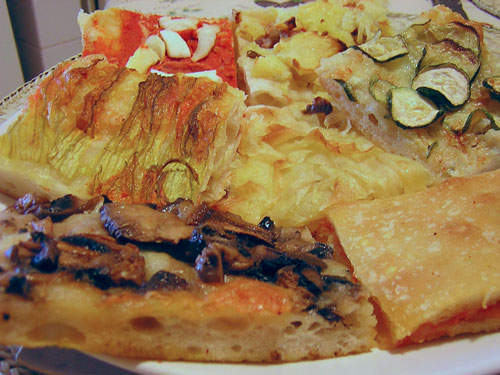
Most pizzas were really good, especially the ones with zucchini blossoms, zucchini and gorgonzola and the one with potatoes herbs and hot sausage from Calabria. Should you ever be in the center of Naples looking for a quick snack this is a good address to keepin mind. The place is on vico Pisanelli, between Via Toledo and the Castel Nuovo, close to the San Carlo Theater and Royal Palace.
-
I have a question, in our travels around Italy to mozzarella and parmigiana producers, one thing that struck us American students, was that the cows did not have access to outdoor fields to graze in or just to be outside. The cows were in one barn, and twice a day they walked to the milking barn and that was it. It seems as if your buffalo got to go outside. So, my question is: is this standard practise in Italy to not allow the cows or buffalo outside? Or is outside only permitted for organic producers? Or is it just a matter of space? Not that the animals seemed miserable, but it certainly struck us as strange.
Thanks!
I am absolutely not an expert in this. I can only describe what I've seen visiting a few cheese makers in Campania and in the eastern Italian regions. There is a distinction between those who rise their cows in the mountains and hills (few) and the big industrial and semi-industrial producers in the Po plain. In the mountains cows are mostly free to graze alpine meadows during summer, and then move to barns in the winter. In the plains what I've seen is pretty similar to what you describe: cows kept in barns as you describe or small pens. I don't think there's any particular rule that prevents cows from staying outside so I'd assume it has more to do with space per animal ratios. I never saw miserable animals either, but you do taste the difference in the cheese.
For buffalos the situation is somewhat different I think: they need a humid/wet environment to thrive. Actually the disappearance of marshes and wetlands, up to the 1950s reduced buffalo numbers quite a bit. No chance of using cows, sheep or goats as farm animals in those areas, so buffalos came in handy.
-
Those who enjoy Italian wine might be interested in taking a look at the list, hot from the press, of the wines awarded with the Tre Bicchieri prize by the 2006 Slow Food/Gambero Rosso wine guide.
The complete list, plus special prizes, is available on the Slow Food website, here.
-
"Hey, get outta here with that camera!!!!"
"Grrrrr!"
The story actually goes more like this:
Front left buffalo to buffalo in the back - "Grrrr! Stop it! I'm fed up of you using my shoulders as a pillow!"
Buffalo in the back snores
 .That's a similar principle to mozarella we follow here in the U.S.! Except it's in weeks, not hours.
.That's a similar principle to mozarella we follow here in the U.S.! Except it's in weeks, not hours.
Oh yes, we call that cheese "scamorza" in Italy
 .
. -
Since Kevin complained about the delay in the continuation of this thread I'll try to be as speedy as possible now that I'm free of more pressing work commitments

 . So one last post about Cilento before moving to Naples again for a short stop and then on to Sicily.
. So one last post about Cilento before moving to Naples again for a short stop and then on to Sicily.One of the food-related highlights of our trip was definitely our visit to Vannulo, one of the only two producers of organic and raw milk Mozzarella di Bufala in Italy. We had a chance to have a short chat with one of the supervisors of the farm while he showed us the mozzarella shaping phase and buffalo pens, which was extremely interesting even for someone like me who had already visited quite a few buffalo farms and mozzarella producers before, one of the standard organized school-visits if you are a pupil in Campania. Vannulo is unique in a few ways. Their choice to go organic meant they had to completely change the way buffalos are reared, fed and cured. This caused a reduction in the amount of milk produced per animal but also means this milk is much richer in fat, giving an incredibly rich mozzarella. The other characteristic that makes them stand apart from other producers is the fact that they only sell directly on the premises, and its products are so popular that there's always a queue and it is actually better to phone ahead and make a reservation.
I couldn't resist the temptation of a few buffalo pictures; these animals are just great.

And they definitely know how to chill out.

The funniest thing we saw there was this back scratcher, below, in one of the pens. Part of the buffalos are kept in a special "clean" pen, instead of in the more usual mud pens, where they are showered with water at regular intervals. This is done to produce a milk with a decreased bacterial charge without using chemical means. The milk will be used to make the starter culture necessary to acidify the cheese curds, a fundamental step to obtain a stretchable curd and also one that can have a great effect on the taste of mozzarella. The buffalos seemed to be really enjoying the back scratcher and actually stood in a queue to have a go.

Since we could not decide which products to buy we left with about 1.5 kg of mozzarella plus buffalo ricotta, yogurts and butter. Just enough for two meals
 . The mozzarella is sold as bocconcini, bite size pieces, aversana, a 500g mozzarella, treccia, plaited mozzarella, and sometimes as provola, i.e. smoked mozzarella, which we did not manage to try. When you buy these you are advised to eat them in the next eight hours to taste them at their best, something which is quite common in Southern Italy. I absolutely do not agree with this notion. Fresh mozzarella tastes fine, but if you store it in its shipping liquid for about 24 hours (but not longer) you give a chance to those bacteria present in the starter I just mentioned to get to work and give a new deepness to mozzarella's taste. If you wait more than a day the mozzarella will have already started to turn slightly acid, so if you have any left overs the best is cooking with them.
. The mozzarella is sold as bocconcini, bite size pieces, aversana, a 500g mozzarella, treccia, plaited mozzarella, and sometimes as provola, i.e. smoked mozzarella, which we did not manage to try. When you buy these you are advised to eat them in the next eight hours to taste them at their best, something which is quite common in Southern Italy. I absolutely do not agree with this notion. Fresh mozzarella tastes fine, but if you store it in its shipping liquid for about 24 hours (but not longer) you give a chance to those bacteria present in the starter I just mentioned to get to work and give a new deepness to mozzarella's taste. If you wait more than a day the mozzarella will have already started to turn slightly acid, so if you have any left overs the best is cooking with them.Treccia and aversana, between the best mozzarella I ever tasted:
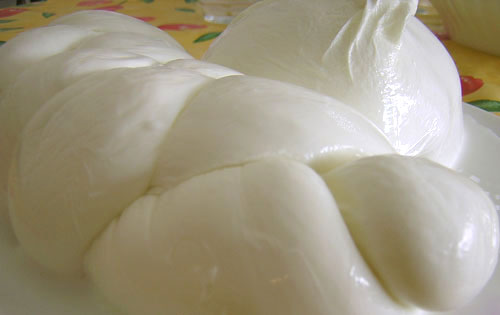
Between all the other products we tasted the best were definitely the coffee yogurt/pudding, rich and with a very strong espresso flavor, and the ricotta. I must admit I'm a sucker for buffalo ricotta: for me it beats any sheep or cow ricotta by miles.

Apart eating it plain on bread, it is great for cooking pasta dishes -my favourite is simply pasta with butter, parmesan, ricotta and a little black pepper- or even sweets. Mix some with a little cocoa, some sugar and a drop of good rhum, sit back and enjoy
 .
. -
Menton1,
thank you for posting about this Italian "diversion". Just curious about the tuna: how far was it cooked? Italians seem to prefer done tuna (well most of them, count me out on this) and I was wondering if this is more of a Sothern Italian thing or if you found the same in Bordighera.
-
“Pasta Asciutta alla Marchigiana differs from ordinary pasta in that it is made from bread dough,
.....
Is the asciutta part of the name right? Is it a dried pasta?
"Pasta asciutta" is normally used to define pasta dishes dressed with sauce as opposed to dishes where pasta is used in a soup, so in this case "asciutta", dry, has only a relative value. As far as I can tell (based on my relatives
 ), the term is often used in Northern and Central Italy, where what we today define as "normally suced" pasta dishes are only one of the possibilities to use pasta offered by traditional cuisine, wheras in the South you'll very hardly ever hear anyone use it, except in restaurant menus, since the main use for pasta is in sauced "dry" pasta dishes and there is therefore no need to distinguish between those and soups.
), the term is often used in Northern and Central Italy, where what we today define as "normally suced" pasta dishes are only one of the possibilities to use pasta offered by traditional cuisine, wheras in the South you'll very hardly ever hear anyone use it, except in restaurant menus, since the main use for pasta is in sauced "dry" pasta dishes and there is therefore no need to distinguish between those and soups. -
the meat of the bufala is a ubiquitous product in that area and, I agree, quite tasty. At Seliano we had it a number of different ways, all excellent.
I imagine it's the perfect way to get rid of the excess male buffaloes. The mozzarella makers we visited, Vannulo, had a ratio of something like 1 adult male to 50 females in their farm.
That pizza in particular is making me hungry and I just had lunch!There will be more of that soon

-
Interesting that it is "tunafish bolognese", not ragu etc.

Quite simple to explain actually: in Campania "ragu" is only Neapolitan style ragu, i.e. a sauce based mainly on pork meat (usually ribs) and tomato, traditionally conserva -i.e. sun dried tomato concentrate, what Sicilians call strattu-, but more and more often made with tomato concentrate. What they make up there in Northern Italy is simple "la Bolognese"
 .
.Try to convnce a Neapolitan that ragu Bolognese also deserves to be defined as ragu if you can

 .
. -
Cilento has, as almost every tourist destination, its fair share of "must see" attractions. The compulsory one is definitely the ancient Greek city of Paestum
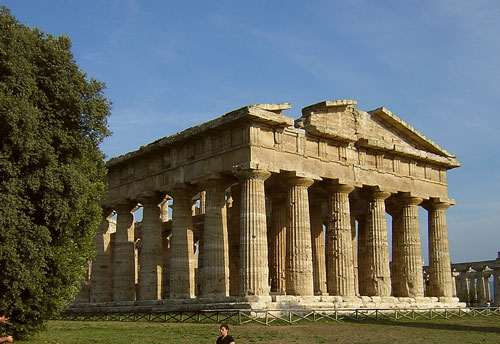
To avoid going too much OT, we paid the newly reorganized excavations museum a visit. Well worth a look, though it suffers from academic stiffens as most Italian museums do. Still, there's plenty of interesting finds to see. I was particularly intrigued by the "votive dishes" section, a small collection of dishes plated with ceramic replicas of food items. Guessing what the unidentified objects were was fun, but even better was looking at the items that strongly recall modern foods. In the one below, for example, the foremost item looks incredibly like a Spanish churro:

Did the Greek invent the pastry bag and churros? And if the latter is true, what did they drip their churros into since they had no chocolate

 ? Fire away Adam
? Fire away Adam  .
.To top our visit to Paestum we decided to follow Slow Food's suggestion and headed to La Pergola in Capaccio Scalo (Via Magna Grecia 1). We had received a few other good tips for the area, Il Ceppo in Agropoli and Nonna Sceppa also in Capaccio Scalo, but our three year old's eating times, adjusted to Germany, forced us to choose a place that opened slightly earlier than 8:30 PM.
Though the food did not blow us away everything was nice and the pizza our son ate (or better he ate half and his dear parents the rest
 ) was really good.
) was really good. A happy but shy kid ready to dig in into his pizza:

We preferred to pick our own from the menu. After a delicious buffalo milk ricotta flavored with lemon rind as pre-appetizer (yes, even trattorie are not immune to this nowadays) and a savory cake filled with ricotta porcini, and zucchini blossoms -OK but not more than that- we continued with some nice mezzanelli with tunafish bolognese,

and a buffalo filet with porcini and runner beans
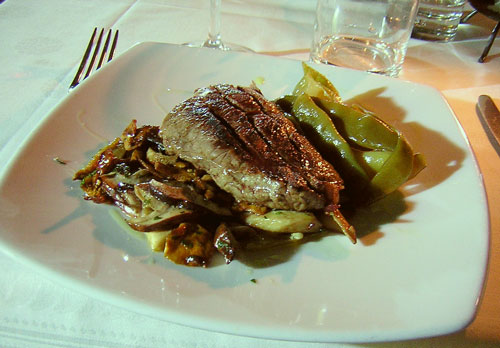
It was my first time with buffalo meat (the European buffalo, the one that makes mozzarella, not the American one) and I found it quite tasty, like a more intense beef. It went really nice with the porcini, less so with the beans. Although we were quite stuffed I couldn't resist sharing a slice of torta caprese with my wife. This is a rather fudgy cake made with lots of almonds, chocolate (and butter), and one of my weak spots when it comes to dessert.
-
The aubergine reference piqued my interest especially,
as your description of aubergine with cherry tomatoes and mozzarella fits an excellent pasta recipe given to me several years ago by an Italian who told me it was from Capri. I'd never seen the particular combination before, and now your report leads toward a possible regional affiliation.
Would you, if you have a chance, elaborate on your preparation? My Italian coworker specified ruote pasta for his dish, which also includes chiffonade of basil.
I'm not sure about it's origin, Capri comes as news to me. It is quite common to call "alla Siciliana" pasta dishes that have the combination of fried aubergines, tomato sauce and cheese of some sort, which goes back to the fact that aubergines were introduced by the Arabs in Sicily and spread from there to the rest of southern Italy.
My recipe is quite simple: I dice my aubergines, 1cm dice, and shallow fry them in olive oil. You could salt them before, as many do, but I personally like the slightly bitter and piquant taste of the aubergines at full power. Once golden I drain them on plenty of kitchen paper and reserve a tiny bit of the frying oil to prepare the sauce. In Italy you find some great canned cherry tomatoes nowaday, so I usually use these, otherwise use quartered raw cherry tomatoes. Once the sauce is ready -I don't use times just taste, you have to lose that raw tomato note- I add the aubergines back in and a few basil leaves and let the flavours blend together while the whole simmers for 5-10 minutes. You could add extra basil on top as chiffonade but you really need to add some to the sauce too to get a good strong basil aroma in there. The pasta i use is any "pasta corta" I have at hand: penne, ziti, tortiglioni... clearly ruote would be fine too. The shape you use is really a matter of personal preference. Once the pasta is dressed in the sauce I tham add about a handful per person of finely chopped mozzarella or provola, i.e. smoked mozzarella. It's important that the pasta is still piping hot when you add the cheese and that you mix really quickly otherwise the cheese won't properly melt, in the first case, or build a gigantic lump in the second.
-
alberto,
which wine do you drink with the dish?
is there is dish which pairs the friggiarielli with meat or sausage?
if yes, could you elaborate?
Wine was a sore point in the first part of mny trip. We didn't manage to find a decent shop in Agropoli, though we didn't look that hard either.
If I remember correctly we drank a light red from Capri called Solaro with the dish, which was unfortunately already past its best. I suspected as much, wines from Capri usually should be drinked young and this was four years old, but I couldn't resist since I had only tasted this once years ago.
I'm addicted to the frigerelli (sp??) pepper. There is only one little old man in the Umbertide market that grows them. I'm a loyal customer. And I agree with you...no cheese, no herbs, the pepper flavor is that full and that good.Lovely photos. Thanks for sharing.
Judith, frigerelli/friggirielli/friggiarielli are all possible spellings depending on where you are. Nice to find another fan here!
-
Alberto, you are making me drool! The fish was beautiful and that pepper sauce looks mighty tasty. The porcini, however, knocked me to the floor. I am always amazeed no matter how often I see or visit them, of the quality of the products in the markets of Italy, France and Spain.
John, the porcini look great don't they? Yet, off all the produce we bought they were maybe the only ones that were slightly disappointing. Unfortunately almost half were past their best, slightly soft and spongy, but luckily you can still use such porcini to make some mighty tasty dried mushrooms, which is exactly what we did.
I completely share your view on markets (and I would add Greece and Portugal to the list), no matter what their size and/or popularity might be. Another striking thing is how specialized in local products those markets are, at least if I compare them to those I experienced here in Germany or in England.
Lovely photographs Alberto, with all those frsh peppers, it is definately not Tuscany. I noticed Dolphinfish for sale in Greece, but was too stupid to eat them at the time, next time I will not be. Do you think the porcini are local or imported from the Balkans etc?Thanks, Adam, I must admit I was inspired by your latest travel reports
 . The porcini are local product: there's plenty in Campania in the woods of Sannio, Irpinia and Cilento. Quite a bit of the stuff that is sold in Tuscany and northwards comes from here, though the Balkans are now the no.1 source.
. The porcini are local product: there's plenty in Campania in the woods of Sannio, Irpinia and Cilento. Quite a bit of the stuff that is sold in Tuscany and northwards comes from here, though the Balkans are now the no.1 source. -
Off to a great start!
No herbs in the pepper sauce then? Pecorino? Mint? How spicy are the peppers?
That's right, no herbs, tough you could add a couple of basil leafs if you wanted. Mint is very rarely used in Campania, mostly for scapece dishes. In a sense the use of herbs (or lack thereof) is one of the many defining aspects of Italian regional cuisines.
Pecorino could work fine, though I would still go for the non-cheese version at first, just to enjoy the pure pepper aroma. The peppers themselves are not spicy at all.
-
Molly, if you plan on visiting D'O reserve NOW!
It might even be too late: last time I heard, sometime in July, they were fully booked out for the coming six weeks. D'O is maybe not the best restaurant in the area of greater Milan, most would say Cracco-Peck is, but it is definitely become the most popular. Chef/owner Davide Oldani definitely had a great idea, though the concept itself it is not much different than that of a gastro-bistro.



Southern Italy
in Italy: Dining
Posted
I can just imagine what your father would have thought . And hanks for the compliments, John, happy you enjoyed the thread.
. And hanks for the compliments, John, happy you enjoyed the thread.
The concept is clearly similar, but the result less so. Burrata has that creamy/liquid quality which you won't find inj the ricotta filled mozzarella. There it is more a case of smooth/rich mouthfeeling, with a little of that refreshing sensetion I find ricotta always seems to have.